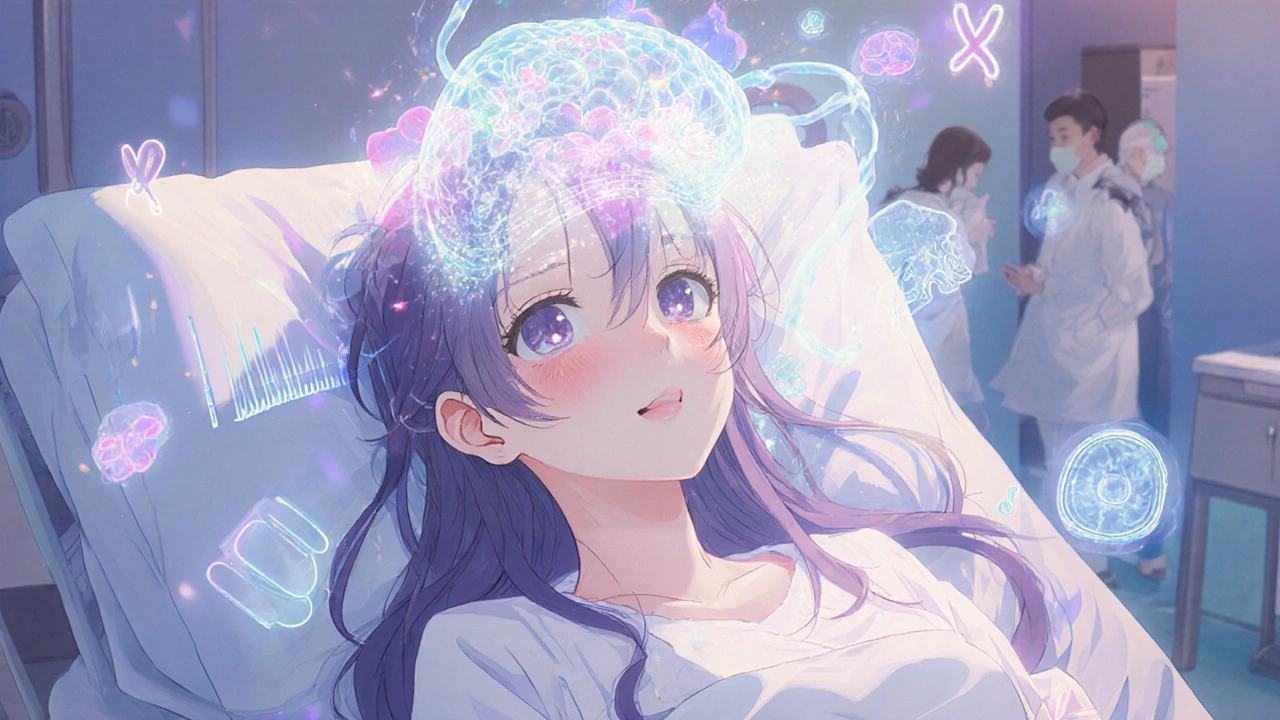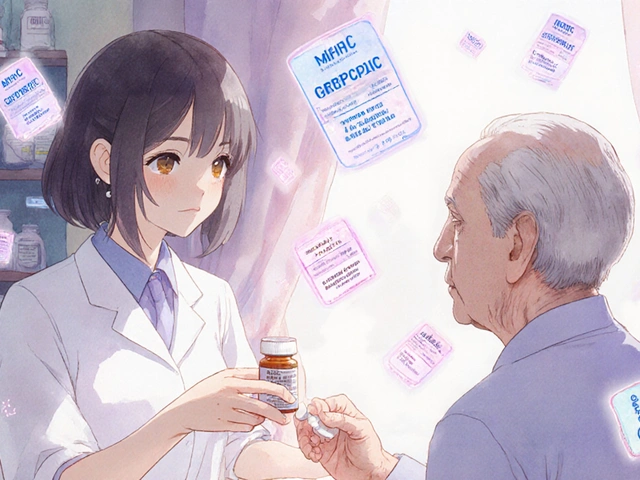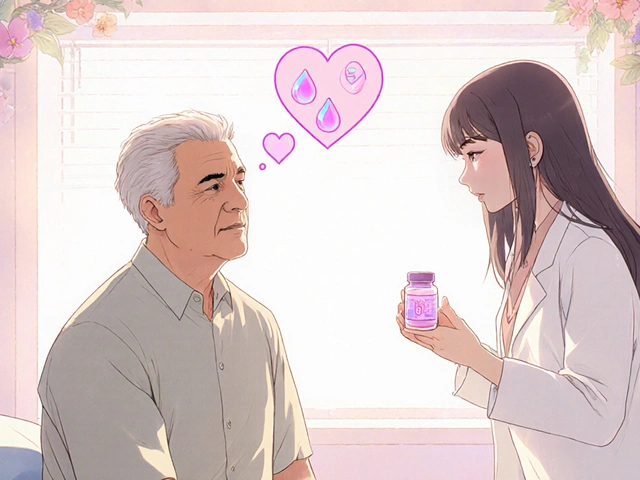
What Is Autoimmune Encephalitis?
Autoimmune encephalitis is a condition where the body’s immune system mistakenly attacks proteins in the brain, causing inflammation and neurological dysfunction. Unlike viral or bacterial encephalitis, this isn’t caused by an infection-it’s an internal error. The immune system produces antibodies that target neurons, disrupting how brain cells communicate. This can lead to seizures, memory loss, confusion, and even life-threatening complications if not caught early.
Before 2007, many of these cases were misdiagnosed as psychiatric disorders or viral brain infections. That changed when Dr. Josep Dalmau identified anti-N-methyl-D-aspartate receptor (anti-NMDAR) encephalitis in young women with ovarian tumors. Since then, over 20 different autoantibodies have been linked to specific forms of this disease. Today, autoimmune encephalitis is recognized as one of the most treatable forms of brain inflammation-if diagnosed quickly.
Red Flags That Shouldn’t Be Ignored
Autoimmune encephalitis doesn’t hit all at once. It creeps in over days or weeks. The first signs are often subtle, which is why so many people are misdiagnosed at first. If someone you know suddenly starts acting out of character, it’s not just stress-it could be this condition.
- Seizures that don’t respond to standard epilepsy meds-especially if they’re new or different from past episodes.
- Memory loss so severe it disrupts daily life, like forgetting names of close family members or getting lost in familiar places.
- Psychiatric symptoms that appear suddenly: paranoia, hallucinations, aggression, or severe anxiety with no prior history.
- Changes in movement: uncontrolled muscle spasms, especially in the face and arms (called faciobrachial dystonic seizures).
- Autonomic problems: heart rate spikes, blood pressure drops, excessive sweating, or trouble regulating body temperature.
- Sleep disruption: insomnia for days, or sleeping 16 hours a day with no energy.
- Prodromal symptoms (appearing 1-4 weeks before brain symptoms): fever, headache, diarrhea, or cold-like symptoms that don’t go away.
These symptoms often show up together. A person might have memory problems, then start having seizures, then become aggressive-all within a few weeks. That’s not typical depression or bipolar disorder. That’s autoimmune encephalitis.
Key Antibodies and What They Mean
Not all autoimmune encephalitis is the same. The type of antibody involved determines the symptoms, treatment, and prognosis. There are two main groups: those targeting surface proteins (easier to treat) and those targeting inside the neuron (often linked to cancer).
| Antibody | Typical Age Group | Key Symptoms | Cancer Link | Response to Treatment |
|---|---|---|---|---|
| Anti-NMDAR | Young adults (median 21) | Psychiatric symptoms, seizures, memory loss, movement disorders | 50-80% with ovarian teratoma (in women) | 70-80% recover well if treated early |
| Anti-LGI1 | Older adults (median 60) | Faciobrachial dystonic seizures, hyponatremia, confusion | Low (under 5%) | 55% achieve full recovery; 35% recur |
| Anti-GABABR | Adults over 50 | Seizures, memory loss, altered mental state | 50% with small cell lung cancer | Good response if tumor removed; 25% mortality |
| Anti-CASPR2 | Middle-aged adults | Neuromyotonia, insomnia, pain, autonomic issues | 15-20% with thymoma | 60-70% respond to immunotherapy |
| Anti-GFAP | Adults, more common in women | Meningoencephalitis, optic neuritis, spinal cord involvement | Rare | High response to steroids; often relapsing |
Testing for these antibodies requires both blood and spinal fluid (CSF). CSF is more sensitive-especially for anti-NMDAR. A negative blood test doesn’t rule it out. That’s why doctors should test both if suspicion is high.
How It’s Diagnosed: Beyond the Symptoms
There’s no single test for autoimmune encephalitis. Diagnosis is a puzzle made of clinical signs, lab results, and imaging. The 2023 International Consensus Criteria help doctors piece it together.
- CSF analysis: White blood cell count is usually under 100 per microliter (much lower than in infections). Protein is mildly elevated. Oligoclonal bands are typically absent.
- MRI brain scan: May look normal in up to half the cases. When abnormal, it shows swelling in the temporal lobes (limbic encephalitis) or patchy enhancement.
- EEG: Shows slowing of brain waves in 76% of cases. Unlike viral encephalitis, it rarely shows the telltale periodic spikes.
- Tumor screening: Essential for anti-NMDAR and anti-GABABR cases. Pelvic ultrasound and CT scans of chest/abdomen are standard. Repeat screening at 4-6 months is critical-some tumors appear months later.
Doctors rule out infections (like herpes simplex), stroke, and metabolic disorders before confirming autoimmune encephalitis. If all else is excluded and the clinical picture matches, treatment starts-even before antibody results come back.

First-Line Treatments: Acting Fast Saves Brains
Time is brain. Every day of delay reduces the chance of full recovery. The 2022 International Consensus Guidelines recommend starting treatment within days of symptom onset.
- Intravenous methylprednisolone: 1 gram per day for 5 days. This high-dose steroid suppresses the immune attack. About 68% of patients show improvement within 7-10 days.
- Intravenous immunoglobulin (IVIg): 0.4 grams per kilogram of body weight daily for 5 days. It neutralizes harmful antibodies. Works well alone or with steroids.
- Plasma exchange: Used for critically ill patients. Removes antibodies directly from the blood. Five to seven sessions over two weeks can lead to 65% improvement.
If a tumor is found-like an ovarian teratoma in anti-NMDAR cases-removing it is the most important step. In 85% of cases, neurological symptoms improve within four weeks after surgery.
Second-Line Options When First-Line Fails
One in three patients don’t respond to steroids and IVIg. That’s when second-line drugs come in.
- Rituximab: A drug that kills B-cells (the antibody factories). Given weekly for four weeks. Response rate: 55%.
- Cyclophosphamide: A stronger chemotherapy-like drug. Monthly infusions for six months. 48% respond.
- Tocilizumab: A newer option that blocks interleukin-6, a key inflammation driver. Early data shows 52% improvement in refractory cases.
These drugs are powerful and come with risks-infections, low blood counts, liver stress. But for patients who don’t respond to first-line therapy, they’re often the only path to recovery.
Long-Term Recovery and What to Expect
Recovery isn’t linear. Most people improve over months, not weeks. But the outcome depends heavily on how soon treatment started.
- Patients treated within 30 days: 78% achieve good recovery (mRS ≤2-able to walk unassisted and care for themselves).
- Those treated after 45 days: Only 42% reach that level.
Complete recovery happens in 55% of anti-LGI1 cases, but only 45% of anti-NMDAR cases after two years. Some people are left with lasting issues:
- Memory and concentration problems (32%)
- Depression or anxiety (28%)
- Seizures needing ongoing medication (22%)
- Movement disorders (15%)
Recovery isn’t just about drugs. Rehabilitation matters:
- Cognitive rehab: Structured therapy for 12 weeks improves memory function in 65% of patients.
- Psychiatric care: SSRIs help 70% of those with post-encephalitis depression.
- Physical therapy: Improves motor control in 50% of patients with movement issues within 8 weeks.
- Sleep support: Melatonin (3-5 mg at bedtime) helps 60% with insomnia.
- Autonomic management: Beta-blockers reduce heart rate spikes in 75% of cases.

Recurrence and Monitoring
Autoimmune encephalitis can come back. Anti-NMDAR recurs in 12-25% of cases, usually within 14 months. Anti-LGI1 has an even higher recurrence rate-up to 35%, often after stopping treatment too soon.
That’s why follow-up is non-negotiable:
- Neurology check-ups every 3-6 months for the first two years.
- Repeat tumor screening every 4-6 months for high-risk antibodies.
- Monitoring GFAP levels in CSF (emerging biomarker) may help detect relapse before symptoms return.
Some patients need long-term immunosuppression. Others can taper off safely. It depends on the antibody, response to treatment, and whether a tumor was found.
What’s Next in Research
The field is moving fast. New treatments are in clinical trials:
- B-cell depletion agents beyond rituximab-like ocrelizumab-are showing promise.
- Complement inhibitors (drugs that block immune system amplifiers) are in Phase II trials with 60% response in refractory cases.
- Biomarkers like GFAP and neurofilament light chain are being tested to predict flare-ups and track treatment response.
One thing is clear: early action saves lives. The window for the best outcome is narrow. If you suspect autoimmune encephalitis, don’t wait for a perfect diagnosis. Start treatment while testing is underway.
Can autoimmune encephalitis be cured?
Many people recover fully, especially if treated early. About 55-80% of patients achieve good outcomes with timely immunotherapy. But some are left with lasting cognitive or psychiatric issues. Complete cure is possible, but long-term monitoring is needed because relapses can occur.
Is autoimmune encephalitis contagious?
No. It’s not caused by a virus or bacteria, and you can’t catch it from someone else. It’s an autoimmune condition-your own immune system attacks your brain. It’s not infectious, but it can be triggered by tumors or, rarely, after infections.
Can children get autoimmune encephalitis?
Yes. While anti-NMDAR encephalitis is most common in young women, children-especially girls-can also develop it. In kids, it often follows a viral illness. Symptoms may include behavior changes, seizures, and movement disorders. Treatment is similar to adults, but dosing is adjusted for weight.
Why does it take so long to diagnose?
Because symptoms mimic psychiatric disorders, epilepsy, or infections. Many patients are first seen by psychiatrists or ER doctors who don’t consider autoimmune causes. Antibody tests aren’t always ordered quickly, and MRI results can be normal. Delayed diagnosis is common-often 6-8 weeks from first symptoms.
Should I get tested for antibodies if I had a brain infection?
Only if symptoms persist or worsen after the infection clears. Some people develop autoimmune encephalitis after a viral illness-a condition called post-infectious encephalitis. If you’re still having memory loss, seizures, or mood changes months after a virus, ask your neurologist about antibody testing.
What’s the survival rate for autoimmune encephalitis?
With prompt treatment, over 90% survive. Death usually happens when treatment is delayed, or if there’s an undiagnosed cancer-like lung cancer in anti-GABABR cases. Early detection and tumor removal dramatically improve survival.
What to Do If You Suspect Autoimmune Encephalitis
If someone you know shows sudden neurological or psychiatric changes-especially with seizures, memory loss, or autonomic symptoms-don’t wait. Go to a hospital with neurology expertise. Bring a list of symptoms and when they started. Ask specifically: "Could this be autoimmune encephalitis?" Request CSF analysis and antibody testing. Don’t let it be dismissed as stress or depression. This is a medical emergency with a treatment window that closes fast.





There are 12 Comments
shreyas yashas
Anti-NMDAR is wild-kids come in acting like they're possessed, then 3 weeks after tumor removal, they're back to playing cricket. It's like flipping a switch.
Suresh Ramaiyan
Katy Bell
Turns out, she had anti-LGI1. Took 8 weeks to get diagnosed. She’s better now but still gets anxious in crowds. I’ll never ignore weird neurological stuff again.
Ragini Sharma
Dalton Adams
And don't get me started on the fact that anti-GFAP is still being lumped with MS in some hospitals. That's not just negligence-it's malpractice.
Kane Ren
My sister got diagnosed at 22. She's running marathons now. It's not magic-it's timing.
Karla Morales
It’s not just a medical issue. It’s a societal failure. 🧠💔
Javier Rain
And if you’re a doctor? Stop dismissing weird cases. We’re not all just crazy.
Laurie Sala
Lisa Detanna
Richard Wöhrl
Pramod Kumar
But now? Now we have names for the monsters. Anti-NMDAR. Anti-LGI1. They’re not ghosts anymore. They’re treatable. And that? That’s hope.
Write a comment
Your email address will not be published. Required fields are marked *